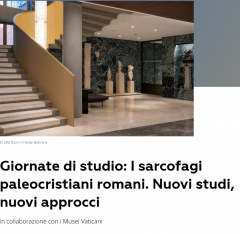Dr Marco Aimone and Stefan Heid are holding a 10-hour special course on early medieval chalices, patens and other vessels and their use in Roman liturgy. The course will take place on 15–16 December and 13 January at the Pontifical Institute of Christian Archaeology..
- Details
- Written by: Stefan Heid
- Category: Roman notes
 Römisches Institut der Görres-Gesellschaft
Römisches Institut der Görres-Gesellschaft
















